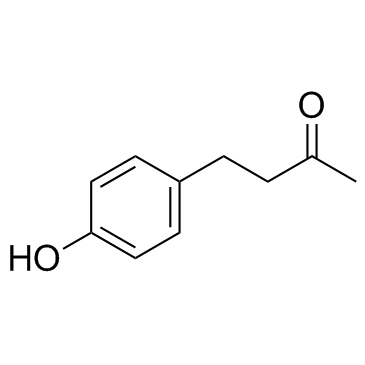4-(4-Hydroxyphenyl)-2-butanone

4-(4-Hydroxyphenyl)-2-butanone structure
|
Common Name | 4-(4-Hydroxyphenyl)-2-butanone | ||
|---|---|---|---|---|
| CAS Number | 5471-51-2 | Molecular Weight | 164.201 | |
| Density | 1.1±0.1 g/cm3 | Boiling Point | 292.2±15.0 °C at 760 mmHg | |
| Molecular Formula | C10H12O2 | Melting Point | 81-85 °C(lit.) | |
| MSDS | Chinese USA | Flash Point | 122.9±13.0 °C | |
| Symbol |

GHS07 |
Signal Word | Warning | |
|
A convenient screening method to differentiate phenolic skin whitening tyrosinase inhibitors from leukoderma-inducing phenols.
J. Dermatol. Sci. 80 , 18-24, (2015) Tyrosinase is able to oxidize a great number of phenols and catechols to form ortho-quinones. Ortho-quinones are highly reactive compounds that exert cytotoxicity through binding with thiol enzymes and the production of reactive oxygen species. Certain phenol... |
|
|
Effect of essential oils, such as raspberry ketone and its derivatives, on antiandrogenic activity based on in vitro reporter gene assay.
Bioorg. Med. Chem. Lett. 20 , 2111-4, (2010) The effect of essential oils, such as raspberry ketone, on androgen (AR) receptor was investigated using a MDA-kb2 human breast cancer cell line for predicting potential AR activity. Among them, eugenol had the highest AR antagonistic activity with its IC(50)... |
|
|
Molecularly imprinted polymers for cleanup and selective extraction of curcuminoids in medicinal herbal extracts.
Anal. Bioanal. Chem 407(3) , 803-12, (2015) This paper describes the synthesis of novel molecularly imprinted polymers (MIPs), prepared by a noncovalent imprinting approach, for cleanup and preconcentration of curcumin (CUR) and bisdemethoxycurcumin (BDMC) from medicinal herbal extracts and further ana... |
|
|
Recent advances in methyl eugenol and cue-lure technologies for fruit fly detection, monitoring, and control in Hawaii.
Vitam. Horm. 83 , 575-95, (2010) Worldwide, an important aspect of invasive insect pest management is more effective, safer detection and control systems. Phenyl propanoids are attractive to numerous species of Dacinae fruit flies. Methyl eugenol (ME) (4-allyl-1, 2-dimethoxybenzene-carboxyla... |
|
|
Purification and biological evaluation of the metabolites produced by Streptomyces sp. TK-VL_333.
Res. Microbiol. 161(5) , 335-45, (2010) An Actinobacterium strain isolated from laterite soils of the Guntur region was identified as Streptomyces sp. TK-VL_333 by 16S rRNA analysis. Cultural, morphological and physiological characteristics of the strain were recorded. The secondary metabolites pro... |
|
|
Biotransformation of raspberry ketone and zingerone by cultured cells of Phytolacca americana.
Phytochemistry 68(4) , 487-92, (2007) The biotransformation of raspberry ketone and zingerone were individually investigated using cultured cells of Phytolacca americana. In addition to (2S)-4-(4-hydroxyphenyl)-2-butanol (2%), (2S)-4-(3,4-dihydroxyphenyl)-2-butanol (5%), 4-[4-(beta-d-glucopyranos... |
|
|
Aroma production by tissue cultures.
J. Agric. Food Chem. 54(4) , 1116-23, (2006) Although plant tissue cultures have been in use for the past hundred years, adapting them for the production of aroma compounds started only in the 1970s. The use of tissue cultures in aroma production has its advantages, because plant cells, unlike whole pla... |
|
|
Production and elicitation of benzalacetone and the raspberry ketone in cell suspension cultures of Rubus idaeus.
Biotechnol. Prog. 16(3) , 346-9, (2000) Production levels of p-coumaric acid (p-CA), p-hydroxyphenylbut-3-ene-2-one (benzalacetone), and p-hydroxyphenyl-2-butanone (raspberry ketone) were measured in raspberry cell suspension cultures to investigate metabolite dynamics in a short (two-step) pathway... |
|
|
Raspberry ketone from submerged cultured cells of the basidiomycete Nidula niveo-tomentosa.
Biotechnol. Prog. 17(3) , 568-72, (2001) The basidiomycete Nidula niveo-tomentosa produced 4-(4-hydroxyphenyl)-butan-2-one (raspberry ketone), one of the character impact components of raspberry flavor, and its corresponding alcohol. A systematic attempt was made to improve the productivity of this ... |
|
|
A labeling study to elucidate the biosynthesis of 4-(4-hydroxyphenyl)-butan-2-one (raspberry ketone) by Nidula niveo-tomentosa.
Appl. Environ. Microbiol. 69(1) , 367-72, (2003) Submerged cells of the basidiomycete Nidula niveo-tomentosa, a microbial producer of 4-(4-hydroxyphenyl)-butan-2-one, were supplemented with (13)C-labeled L-phenylalanines and with [1-(13)C]glucose. Labeled transformation products were detected by a novel met... |